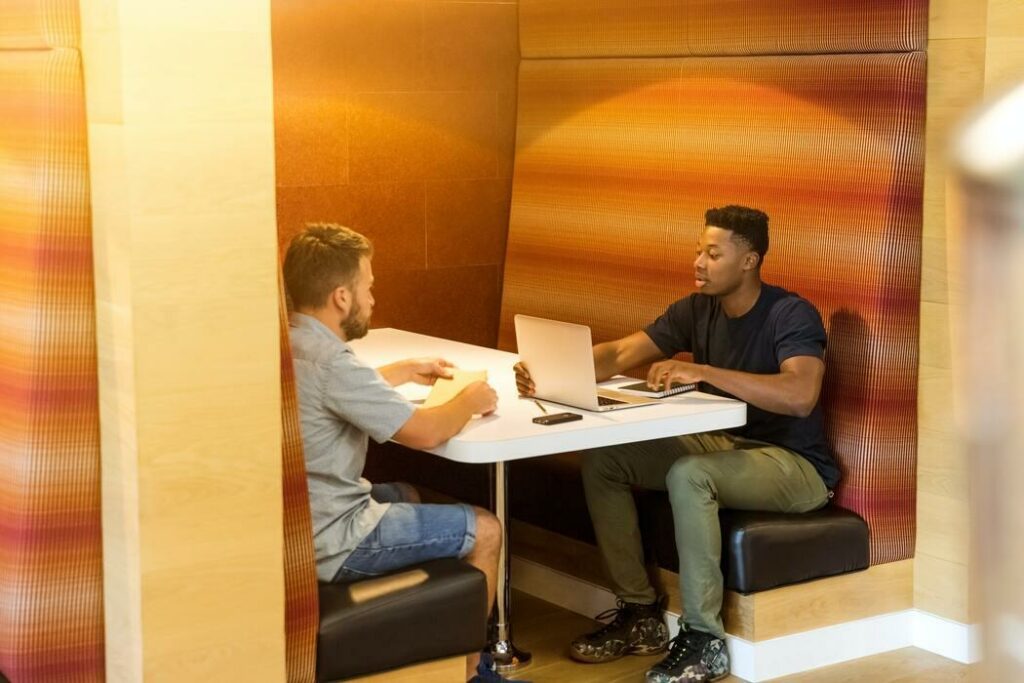The human being is a creature willing to adapt. Ever since the beginning of our existence, we’ve survived climate changes, illnesses, and many historical crises due to our ability to adapt and will to persist no matter what.
The modern world has made us feel way too comfortable and, when Covid-19 came along, our lives were shaken and the future of work was questioned.
The isolation, the fear of being in a contagious environment, and the economic challenges; all of these factors changed forever the way we communicate, study, work, and meet.
Forbes states that technology has made all of these new approaches to our daily activities possible and it keeps altering our professional relationships.
So, now that we’ve gotten used to the changes and we’ve established new norms and rules to follow – what exactly are the post-pandemic workplace trends in the business world?
Asynchronous work
When the majority of people were working in the office and were sharing the same 9-to-5 working hours, we used to ask questions and demand immediate answers.
However, the remote work model almost entirely uprooted this practice. Working from home means that people could be traveling, be in other time zones, be in the middle of a virtual meeting, or have different working hours than the usual ones.
Therefore, unless the request is urgent, one cannot expect an immediate reaction.
There’s no pressure to interrupt what you are currently working on and answer a query.
As long as the job is complete by the end of the day or week, it doesn’t matter whether teammates work in the same time window.
Such flexibility allows employees to distribute their workload as they find a suitable time and works in favor of employers because it provides a vast range of possible hires.
Companies with no physical spaces
The post-pandemic workspace is restructured because companies that switched from an actual office to a digital working environment do not need a physical space anymore.
Team managers have ensured that employees have all the tools needed for their tasks to be successfully completed online.

The officeless approach saves both parties a lot of time and money.
Workers do not have to commute every day, meaning that no money is spent on gas or public transportation.
Some people with 10-15 years of experience who have formed a family and have kids to look after will most probably appreciate the fully remote work model. However, for some gen Z employees, post-pandemic alienation becomes an issue.
Even so, there’s a solution to every problem…
More team-building activities
Buffer’s survey found that 16% of remote workers experience difficulties with collaboration and another 16% feel lonely.
Companies and organizations do their best to provide employees with the opportunity to meet and get to know each other better even if they are a part of an international team.

This step is essential because forming stronger bonds between colleagues not only relieves the feelings of disengagement and loneliness but also encourages teamwork and productivity.
Team leaders, managers, and employees are brought together to tackle the issue of depersonalization that technology creates.
💡 Pro tip
While a video conferencing solution is sufficient for regular team meetings, 1:1 check-ins, and virtual team buildings, a remote team also requires effective scheduling and workforce management.
Care for employee’s health and well-being
One of the best post-Covid-19 workplace trends is that companies are worried about their employee’s health and well-being more than ever.
Before, workers used to expect employers to take care of their health insurance and provide some well-being packages.
Now, the demand is even stronger.
Companies that prefer their workers to operate on-site need to take all the necessary hygiene and ventilation precautions to prevent the spreading of Covid-19 and other viruses.
Not to mention that the ergonomics, proper lighting, and comfortable seating in the office are not a benefit to the employees anymore, but an absolute must.
As for the remote workers, McKinsey’s report about the Future of work found that at least 49% of them are feeling some symptoms of burnout. Meaning that the high productivity levels could be just a temporary success if measures against exhaustion are not taken.
AI-augmented workforce
The AI-augmented workforce is the future of work because it provides automation of boring and time-consuming tasks that deprive professionals of concentrating on the important stuff.
Lawyers use software to save time from reviewing documents and reports, meanwhile, doctors are meticulously analyzing medical records and scans thanks to their computer vision.

Marketers have a vast range of tools at their disposal to help them target the right audiences with their campaigns.
Store managers are using AI assistants to predict what individual shoppers will be looking for and better plan their inventory and logistics.
As a result, the service provided by all sorts of professionals will be time-efficient and of excellent quality.
Employee monitoring
Coming from there, new methods and platforms are introduced to the market that could be used to oversee the performance of employees and rectify certain practices if needed.

Even though this is a necessary step to prevent employees from taking advantage of the officeless work model and ensure that no one is failing to fulfill their duties, it could be seen as an overbearing and invasive technique.
Companies that invest in employee monitoring software have a fine line to tread and the effect of it on the individual’s feeling of freedom remains to be seen.
Favoring skills over roles
Another beneficial example of the post-pandemic workplace trends is the disruption of hierarchies.
Nowadays the skillset that one possesses is more important than their assigned role in the company.
The ‘flat’ organizational structure is the complete opposite of the strictly hierarchical teams that used to be the norm.

By replacing the chain-of-command approach with open communication and problem-solving conceptualization, teams find themselves much more productive and engaged.
This change in attitude drives companies toward focusing on personal development, innovation, and success rather than encouraging the practice of climbing up the ladder.
Post-pandemic workplace trends – summarized
As we’ve established, the pandemic has changed enormously the way businesses operate.
Some people feel excited and welcome the changes, others feel overwhelmed as they struggle to take in the digital world.
In any case, all the above-mentioned post-pandemic workplace trends are here to stay and we have to rely on our adaptive nature once more.
